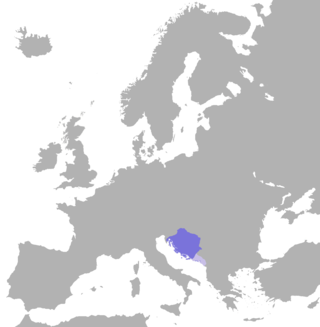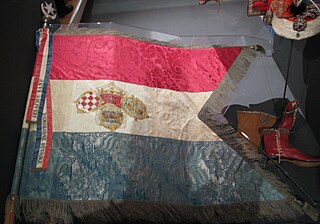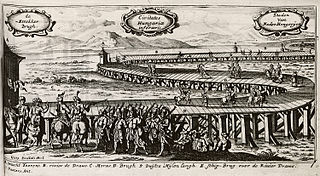Related Research Articles
At the time of the Roman Empire, the area of modern Croatia comprised two Roman provinces, Pannonia and Dalmatia. After the collapse of the Western Roman Empire in the 5th century, the area was subjugated by the Ostrogoths for 50 years, before being incorporated into the Byzantine Empire.

The kuna was the currency of Croatia from 1994 until 2023, when it was replaced by the euro. The kuna was subdivided into 100 lipa. It was issued by the Croatian National Bank and the coins were minted by the Croatian Mint.

The Kingdom of Croatia, or Croatian Kingdom, was a medieval kingdom in Southern Europe comprising most of what is today Croatia, as well as most of the modern-day Bosnia and Herzegovina. The Croatian Kingdom was ruled for part of its existence by ethnic dynasties, and the Kingdom existed as a sovereign state for nearly two centuries. Its existence was characterized by various conflicts and periods of peace or alliance with the Bulgarians, Byzantines, Hungarians, and competition with Venice for control over the eastern Adriatic coast. The goal of promoting the Croatian language in the religious service was initially introduced by the 10th century bishop Gregory of Nin, which resulted in a conflict with the Pope, later to be put down by him. In the second half of the 11th century Croatia managed to secure most coastal cities of Dalmatia with the collapse of Byzantine control over them. During this time the kingdom reached its peak under the rule of kings Peter Krešimir IV (1058–1074) and Demetrius Zvonimir (1075–1089).

The Kingdom of Croatia-Slavonia was a nominally autonomous kingdom and constitutionally defined separate political nation within the Austro-Hungarian Empire. It was created in 1868 by merging the kingdoms of Croatia and Slavonia following the Croatian–Hungarian Settlement of 1868. It was associated with the Kingdom of Hungary within the dual Austro-Hungarian state, being within the Lands of the Crown of St. Stephen, also known as Transleithania. While Croatia had been granted a wide internal autonomy with "national features", in reality, Croatian control over key issues such as tax and military issues was minimal and hampered by Hungary. It was internally officially referred to as the Triune Kingdom of Croatia, Slavonia and Dalmatia, also simply known as the Triune Kingdom, and had claims on Dalmatia, which was administered separately by the Austrian Cisleithania. The city of Rijeka, following a disputed section in the 1868 Settlement known as the Rijeka Addendum, became a corpus separatum and was legally owned by Hungary, but administered by both Croatia and Hungary.

The counties of Croatia are the first-level administrative subdivisions of the Republic of Croatia. Since they were re-established in 1992, Croatia has been divided into 20 counties and the capital city of Zagreb, which has the authority and legal status of both a county and a city. As of 2015, the counties are subdivided into 128 cities and 428 municipalities. The divisions have changed over time since the medieval Croatian state. They reflected territorial losses and expansions; changes in the political status of Dalmatia, Dubrovnik and Istria; and political circumstances, including the personal union and subsequent development of relations between the Kingdom of Croatia-Slavonia and the Kingdom of Hungary.
Matko Talovac or Matija Talovac, was a Croatian nobleman, a member of the Talovac noble family. He served as Ban (Viceroy) of Slavonia from 1435 and Ban of Croatia from 1436, until his death in 1444 or 1445.
Ban of Croatia was the title of local rulers or office holders and after 1102, viceroys of Croatia. From the earliest periods of the Croatian state, some provinces were ruled by bans as a ruler's representative (viceroy) and supreme military commander. In the 18th century, Croatian bans eventually became the chief government officials in Croatia.

Parliamentary elections were held in the Kingdom of Croatia-Slavonia on 28 October 1910 to elect the members of the Sabor. The elections were called by ban Nikola Tomašić after the adoption of a new Law of the Electoral Order.

The Croatian–Hungarian Settlement was a pact signed in 1868 that governed Croatia's political status in the Hungarian-ruled part of Austria-Hungary. It lasted until the end of World War I, when the Croatian Parliament, as the representative of the historical sovereignty of Croatia, decided on October 29, 1918 to end all state and legal ties with the old Austria-Hungary.

The Triune Kingdom or Triune Kingdom of Croatia, Slavonia and Dalmatia was the concept—advocated by the leaders of the 19th-century Croatian national revival—of a united kingdom between Croatia, Slavonia and Dalmatia, which were already within the Austrian Empire under one king, who was also the Emperor of Austria, but were politically and administratively separate entities. This concept had roots in the high medieval period, as a successor to the historical Kingdom of Croatia which was made up of those regions.
The Royal Court Table of Zagreb was the main court of first instance in the Kingdom of Croatia-Slavonia between 1850 and 1918.

Samuel "Sami" David Alexander was a Croatian Jewish industrialist, doyen of Croatian industrialists, a philanthropist and a member of the Zagreb prominent Alexander family.

The Berislavić family of Grabarje, also known as Berislavić family of Dobor, , was a Croatian noble family from the Požega County of Slavonia, allegedly originating from Ban Borić.
The Duke of Slavonia, also Duke of Dalmatia and Croatia and sometimes Duke of "Whole Slavonia", Dalmatia and Croatia was a title of nobility granted several times in the 13th and 14th centuries, mainly to relatives of Hungarian monarchs or other noblemen. The title of duke signified a more extensive power than that of the Ban of Slavonia or Ban of Croatia.
The Social Democratic Party of Croatia and Slavonia was a social-democratic political party in the Kingdom of Croatia-Slavonia. The party was active from 1894 until 1916.
Neven Budak is a Croatian historian and professor at the Faculty of Humanities and Social Sciences, University of Zagreb.

Mother Croatia is the female personification of Croatia and a national emblem of the nation.

The Great Turkish War of 1684–1689 saw conflict between the Holy League and the Ottoman Empire in territories of Croatia, Slavonia and Dalmatia. The war was concluded by the Treaty of Karlowitz in 1699, which significantly eased the Ottoman grip on Croatia.

The siege of Sokolac was a siege of Sokolac Castle in Brinje, Kingdom of Croatia, in August 1493, by the joint bans of Croatia John Both de Bajna and Emerik Derenčin, against the Frankopan family, due to the Frankopans' attempt to regain control over the town of Senj. John Both was killed during the siege, and it was eventually abandoned after Derenčin received news of an approaching Ottoman army. The two sides made truce, and fought the Ottomans together at the Battle of Krbava Field the following month.